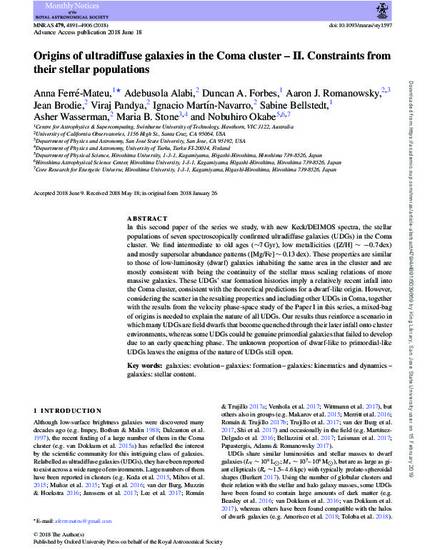
Article
Origins of ultradiffuse galaxies in the Coma cluster – II. Constraints from their stellar populations
Monthly Notices of the Royal Astronomical Society
(2018)
Abstract
In this second paper of the series we study, with new Keck/DEIMOS spectra, the stellar populations of seven spectroscopically confirmed ultradiffuse galaxies (UDGs) in the Coma cluster. We find intermediate to old ages (∼7 Gyr), low metallicities ([Z/H] ∼ −0.7 dex) and mostly supersolar abundance patterns ([Mg/Fe] ∼ 0.13 dex). These properties are similar to those of low-luminosity (dwarf) galaxies inhabiting the same area in the cluster and are mostly consistent with being the continuity of the stellar mass scaling relations of more massive galaxies. These UDGs’ star formation histories imply a relatively recent infall into the Coma cluster, consistent with the theoretical predictions for a dwarf-like origin. However, considering the scatter in the resulting properties and including other UDGs in Coma, together with the results from the velocity phase-space study of the Paper I in this series, a mixed-bag of origins is needed to explain the nature of all UDGs. Our results thus reinforce a scenario in which many UDGs are field dwarfs that become quenched through their later infall onto cluster environments, whereas some UDGs could be genuine primordial galaxies that failed to develop due to an early quenching phase. The unknown proportion of dwarf-like to primordial-like UDGs leaves the enigma of the nature of UDGs still open.
Keywords
- galaxies: evolution,
- galaxies: formation,
- galaxies: kinematics and dynamics,
- galaxies: stellar content
Disciplines
Publication Date
October 1, 2018
DOI
10.1093/mnras/sty1597
Publisher Statement
This article was published in Monthly Notices of the Royal Astronomical Society ©: 2018 The Authors. Published by Oxford University Press on behalf of the Royal Astronomical Society. All rights reserved.
This article can also be found online at the following link: https://doi.org/10.1093/mnras/sty1597
Citation Information
Anna Ferre-Mateu, Adebusola Alabi, Duncan A. Forbes, Aaron J. Romanowsky, et al.. "Origins of ultradiffuse galaxies in the Coma cluster – II. Constraints from their stellar populations" Monthly Notices of the Royal Astronomical Society Vol. 479 Iss. 4 (2018) p. 4891 - 4906 ISSN: 0035-8711 Available at: http://works.bepress.com/aaron_romanowsky/148/
